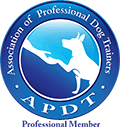Creature Feature :: The Sport of NoseWork
|
Dogs have 300 million olfactory receptors in their noses, making their sense of smell 10,000 to 100,000 more sensitive than ours. This means that a dog could potentially smell one rotten apple in two million barrels! But their superpower sense of smell doesn't stop there. The portion of his brain used for analyzing smell is, proportionally speaking, 40 times greater than that of the human's.
The sport of Canine Nose Work leverages their amazing sense of smell with their natural desire to perform a task. By employing a dog's natural scenting abilities, the activity builds |

|
Developed by a team of professional detection dog trainers in 2006, Canine Nose Work has now reached dogs of all breeds, sizes and ages and has made basic search dog skills available to the com-panion dog while creating a new sport for dog enthusiasts.
A treat (or toy) is hidden inside a cardboard box which is itself planted within an array of other cardboard boxes. Once the dog learns to orient to the cardboard boxes in search of the tasty payload, the target box can be hidden with increasing levels of difficulty among the other boxes.
To get started:
- Collect up to a half dozen boxes, varying in size. Pick one of the smaller boxes to be the target box. This is the only box where food will be hidden.
- With your dog on leash in front of you, hold the target box and toss treats into it, in full view of your dog. Then put the box on the floor and invite him to eat the treats. Pick up the box and repeat this several times. We want him to get box-focused so that he starts investigating boxes with the hopes of finding treats. (For this reason, refrain from offering him treats from your hand; we want him to only troll for treats among the boxes.)
- Now have someone take your dog away. Allow him to watch initially as treats are put in the box and then the box is put down on the floor again, this time with an array of other boxes around it. Leave room between boxes so that he can easily move about in search of the target box. The handler should release him to find the target box by cuing "Go find it!" or "Search!" Repeat this several times, changing the location of the target box among the others. Keep it simple for now.
- As your dog becomes more adept and assured of the game, plant the target box out of sight of your dog and start to hide it, nesting it in another box or tipping a box atop it. Make it only as hard as your dog can succeed at.




